Dog-on-dog aggression can be frightening to both dogs and owners. There are a few things you can do to improve the situation in a multi-dog home or when you and your dog are out and about.
However, in severe cases, aggressive dog behavior needs professional intervention to prevent worsening to the point that the dog becomes a threat to people.
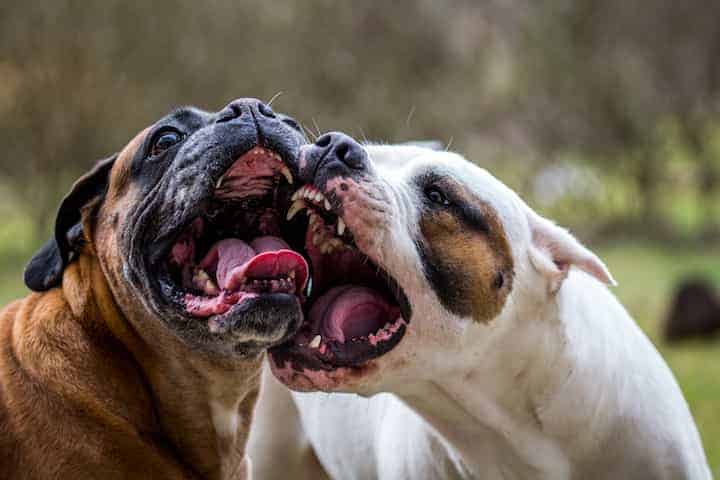
Read on to learn more about what causes it and how to stop dog-on-dog aggression.
Causes of Dog-on-Dog Aggression
Inadequate Socialization
In most cases of dog-on-dog aggression, the cause is poor socialization from puppyhood.
Lack of socialization leads to poor canine communication skills. An inadequately socialized dog will have a hard time “reading” another dog’s signals accurately and responding appropriately.
However, there are some specific situations where aggressive dog behavior can occur even with dogs who had appropriate training as a puppy.
These factors include the breed of your dog and his past experiences.
Breed
The breed of the dog can also play a role in dog-on-dog aggression. Some dog breeds were bred to fight. The Pit Bull, the American Staffordshire Terrier, and the Dogo Argentino are good examples.
Other breeds, including sighthounds (such as Greyhounds and Whippets) and scenthounds (such as Beagles and Dachshunds), may also have intense predatory aggression because they were bred to hunt.
Guard dogs and watchdogs (such as German Shepherd Dogs, Rottweilers, and Akitas) may show aggression toward other dogs they see as a threat to their humans or property.
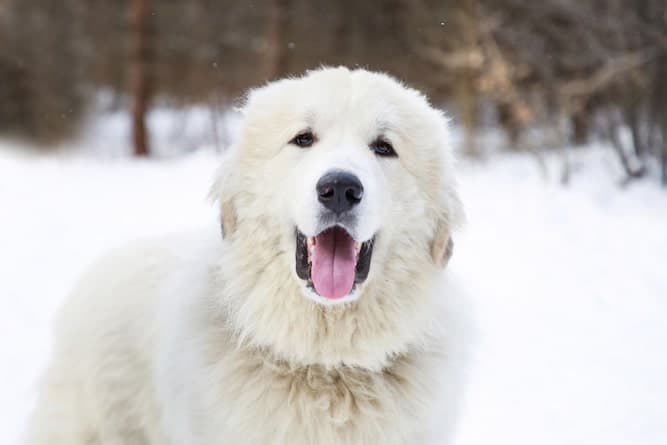
Livestock guardian dogs (such as the Great Pyrenees) can be extremely aggressive in the guarding of their flocks. Some will fight to the death to protect their charges.
Most of these breeds are no longer doing the jobs they were bred to do. However, many of them have retained those instincts.
It can take many generations to breed a nonadaptive (no longer needed) instinct out of a dog. Some breeders are more conscientious about this than others.
In lines that were produced by a puppy mill or backyard breeder, there is no effort at all to breed out aggressive traits.
Learned Behavior
Learned aggression is another common issue, especially with rescue or shelter dogs.
In many cases, a dog learns an aggressive response to fear or anxiety. He has found that it works to manage threats, so he continues it.
Learned aggressiveness can be challenging to correct. To do that successfully, you will need to determine what type of aggression your dog is displaying.
The following are types of dog aggression toward other dogs.
Types of Dog-on-Dog Aggression
Resource Guarding
Resource guarding is another common form of aggression. It can consist of dog-on-dog food aggression or more generalized dominance aggression.
Resource guarding can include fighting over toys, resting places, or anything that a dog finds valuable.
Your dogs also consider you a resource. If you have more than one dog and one feels it’s not getting enough attention from you, this can trigger a competitive relationship and cause aggression.
You should be able to tell which form of resource guarding your dog is exhibiting from observing his body language when he’s involved in a conflict.
Territorial Aggression
Fighting over perceived territory has been a common cause of dog fights since long before humans domesticated them.
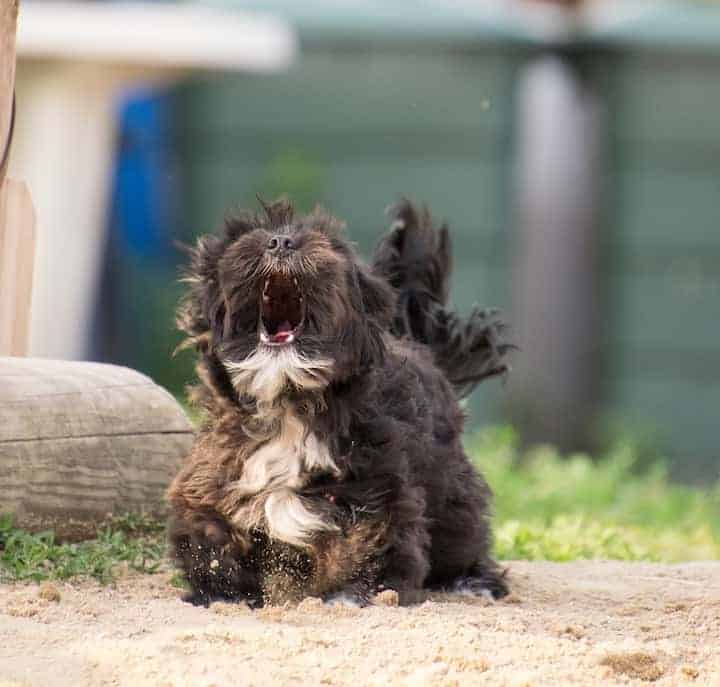
In one study, researchers found that dog-on-dog aggression in the home was more frequent in non-sporting and herding breeds. It was less frequent among sporting and toy breeds.
Outside of the home, terrier breeds were most likely to be involved in aggressive incidents.
Females most often initiated household aggression. But more males attacked other dogs outside of the home.
Interestingly, when fights involved two same-sex dogs, female-on-female dog aggression incidents were the most severe.
Protective Aggression
Dogs may exhibit this if they feel another dog represents a threat to a member of his human family, or in the case of a new mother, her puppies.
Predatory Aggression
Many breeds of dogs (for example, hounds and terriers) have strong prey drives that are instinctive and can be challenging to control.
They can become aggressive with smaller dogs and other animals (and even human infants) if they see them as prey.
Sexual Aggression
Sex-related aggression can apply to both males fighting for breeding rights and females competing for access to males.
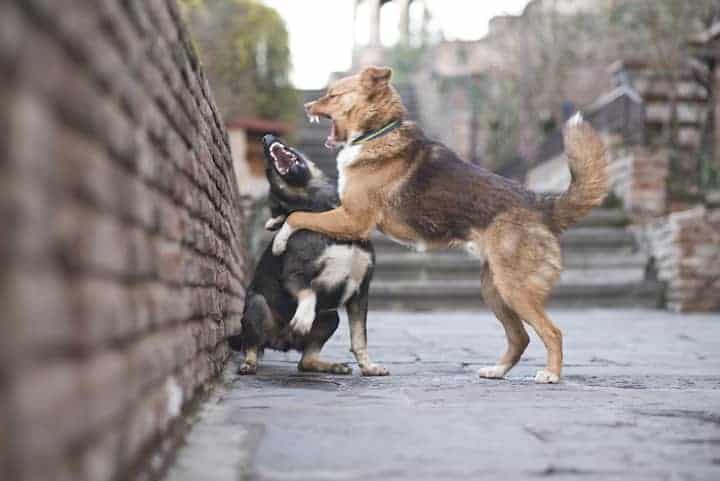
Fear Aggression
Fear aggression is the most common type of dog-on-dog aggression. Many things can cause fear aggression, including owner abuse or past attacks by other dogs.
In fact, most forms of dog aggression have a component of underlying fear or anxiety. Dogs most often strike out when they feel cornered.
Their natural defensive reaction is the classic “fight or flight” response. When dogs feel they are vulnerable and have no escape route, many will cower in defense at first.
When that doesn’t defuse the situation, they will strike.
But some dogs will go straight into offensive mode and attack with no preceding defensive reaction.
Leash Aggression
One of the most common canine behavior problems is dog aggression towards other dogs when walking on a leash. A leash-aggressive dog will lunge, bark, and sometimes snap at oncoming dogs.
According to the American Kennel Club (AKC), leash aggression can be a combination of frustration and tension.
Despite what it looks like, your dog may be telling the other dog, “I want to be your friend, but I can’t get to you because I’m confined by this leash!”
But that other dog’s owner is probably hearing, “I don’t have the social skills to play nice.” In most cases, they would be right.
Dominance Aggression (also called Social Aggression)
True dominance aggression is rare, according to Sophia Yin, DVM, but it does happen, toward both humans and other dogs.
Dominance aggression is a more serious form of resource guarding where a dog guards all resources that he feels are valuable.
A typical resource guarder is anxious or afraid he may lose something valuable.
But a dominant-aggressive dog is acting on a need to put dogs he considers lower than himself in the social hierarchy “in their place.”
You could call him a bully.
Prevention of Inter-Dog Aggression
So how do you prevent a dog from becoming a bully? In most cases, socialization.
Socialization of a Puppy
The most effective way to prevent dog-on-dog aggression is to socialize them well as puppies.

Dogs need positive interactions with other dogs from a very young age to teach them that other canines are friends and are not to be feared.
When your pup is young, take him to a puppy preschool that is managed by a competent and experienced trainer.
Continue his training as he grows up with obedience classes where he can meet other dogs in a positive, supportive environment.
You want your puppy to meet as many people as possible while he’s young and visit as many places as possible. The goal is for that pup to be confident in any environment.
Socialization should be a lifelong process, especially for breeds that have a genetic disposition toward aggressiveness.
Socialization of an Adult Dog
Newly rescued adult dogs are likely to have socialization issues. Dealing with dog-on-dog aggression with an adult dog is more challenging than with a puppy.
But the principles are the same: positive reinforcement, no punishment, and taking it slow.
For more tips on how to socialize an adult dog, see Dog Aggression: How to Deal with Aggressive Dog Behavior.
Warning Signs of Dog-on-Dog Aggression
Whatever the cause of your dog’s aggression toward other dogs, it’s important that you recognize the warning signs that he is about to become aggressive.
Before an actual attack, dogs will usually exhibit body language that a savvy dog owner will recognize.
They might show appeasement signals, which are a dog’s way of trying to avoid conflict.
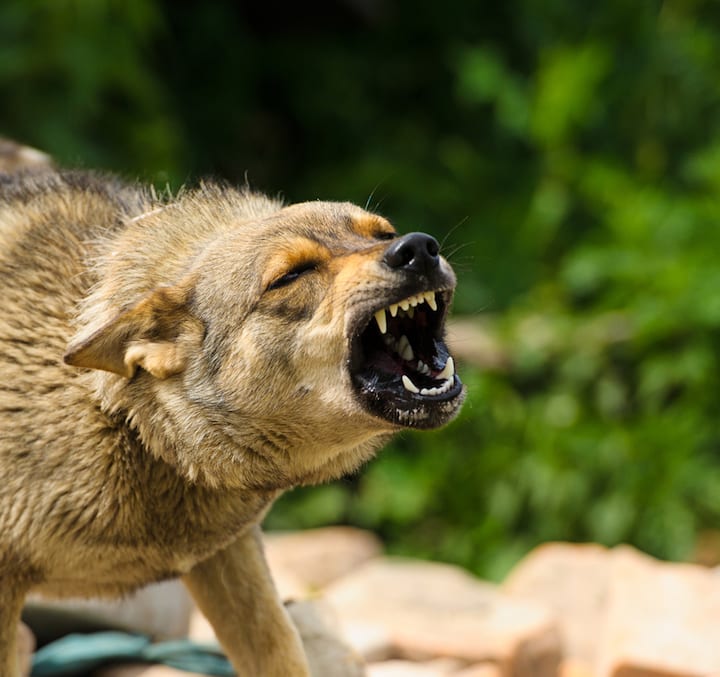
VCA Hospitals (Drs. Martin and Buzhardt) share on their website that appeasement signals can include (in order of escalation):
- Trying to back away.
- Turning or looking away to avoid eye contact.
- Licking the lips or yawning.
- Flattening the ears back close to the head.
- Tucking the tail under the body or crouching, trying to appear smaller.
- Stiffening of the body.
- Growling.
- Snapping.
- Biting.
Learning to read your dog’s body language and triggers is the first step in developing an effective treatment plan.
Treating Aggressive Dog Behavior Toward Other Dogs
If your dog is exhibiting dog-on-dog aggression behavior, you must not ignore it. An aggressive dog is not a happy dog. Most aggression is a sign of fear and anxiety that your dog lives with—in some cases, every day.
More importantly, you are responsible for any harm your dog does to another dog or person.
Depending on the dog-on-dog aggression laws in your state, you can be held legally and financially responsible for any injuries your dog causes.
And you could lose your dog.
Read more about aggressive dogs and the law in “How to Prevent and Stop Dog Biting.”
Then follow these tips on how to correct dog-on-dog aggression:
Get Your Dog a Medical Checkup
The first step to dealing with dog aggression is to schedule a checkup with your vet. Pain from an injury or illness sometimes causes aggression.
A vet exam is especially important in cases of sudden aggression in a dog who didn’t exhibit it before. A medical condition needs to be ruled out before proceeding with treatment.
In cases of a sudden onset of aggression, vets will sometimes order an MRI to look for a neurological condition.
Spay or Neuter
If your dog is intact, spaying or neutering will help to reduce aggressive conflicts. This will eliminate sexually aggressive behaviors in both males and females.
Ensure Adequate Exercise
Be sure your dog is getting enough exercise. Not getting the activity he needs can contribute to a dog’s aggression.
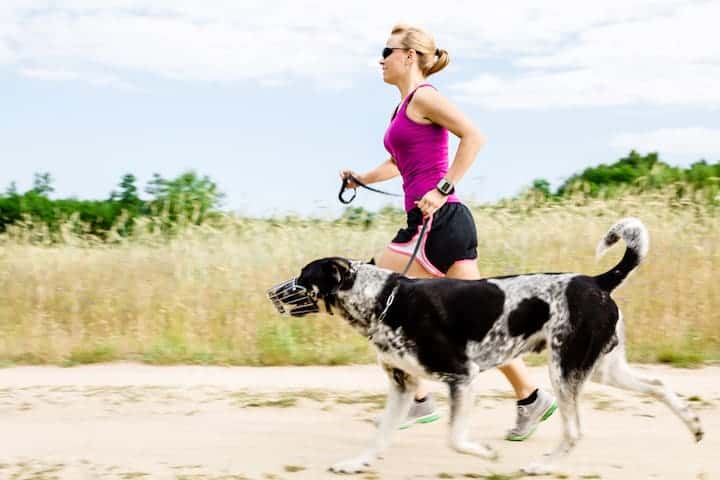
He needs daily opportunities to vent pent-up energy. This is critically important to prevent frustration in dogs, particularly breeds who have high energy levels.
In a multi-dog home, adequate exercise is imperative. Having more than one dog that can’t expend its energy can exacerbate aggressive incidents.
Research the recommended level of exercise for your breed(s), pay attention to their cues, and then see that they get it.
Have a Plan for Resource Guarding
If your dogs are fighting over food and toys, then you will need to separate them for mealtimes. Keep toys well out of reach and only play with them under controlled circumstances.
Give all your dogs plenty of one-on-one attention, so they don't see you as a resource that they need to fight for.
Avoid Punishment!
Positive reinforcement is by far the best way to deal with problem behaviors, and dog-on-dog aggression is no exception.
According to UC Davis Veterinary Medicine, punishment techniques like alpha rolls, leash corrections, verbal disrupters, shoulder jabs, and training disks or chains that are tossed at dogs don’t get to the root of the problem.
They don’t deal with the underlying emotion or motivation for a dog’s aggressive behaviors.
Many trainers and behavioralists now feel that these methods are outdated.
Worse, punishment methods will increase your dog’s fear and anxiety, which will only lead to more aggression.
Imagine if you were punished every time you met a person on the street who made you uncomfortable. Wouldn’t you begin to fear meeting that person?
That's precisely what happens with your dog. He will always associate meeting a strange dog with punishment and will act from fear every time.
Punishing your dog for exhibiting any of these warning signs may teach him other lessons you don’t want him to learn, as well.
For example, if you punish your dog when he growls, he may learn to attack with no warning instead.
Finally, punishing training methods can weaken your bond with your dog.
The Whole Dog Journal writes that the key to dealing with aggression is to have your dog look to you when he needs guidance, not to be submissive or afraid of you.
We’re going for leadership here, not dominance over your dog.
You want your dog to associate you not with pain and frustration but with trust and respect. He will be much more willing to learn from you.
Positive reinforcement training and behavior modification methods are the most effective and humane tools for changing your dog’s behavior.
Behavior Modification Techniques
Positive reinforcement training works because it focuses on changing the emotion behind a dog’s aggression.
At the same time, it reinforces the behaviors you want.
The following are effective changes you can make that do not involve punishment.
In the Home
“Learn to Earn” (aka “Say Please” or “Nothing Good in Life is Free”)
We’ve heard this program called by all these names, but the principle is the same. It’s a simple plan that can work wonders in reducing your dog’s aggression.
Simply put, you train your dog to “say please” for anything and everything that he wants with an automatic sit.
This method will train your dog that all good things come from you. Having to ask for everything he wants makes your dog realize that he is not the dominant partner in the relationship—you are.
Your dog will gradually become less aggressive as he learns he must ask for what he wants.
To learn more about Learn to Earn dominance training, see Dog Aggression: How to Deal with Aggressive Dog Behavior.
NOTE:
If the situation in your home involves severe aggression, get professional help. We do not recommend dealing with severe aggression on your own!
Outside the Home
The most common form of dog aggression toward other dogs outside the home is leash aggression.
Although leash-aggressive dogs rarely follow through with a bite, the experience is frightening and uncomfortable enough to make their owners decide to limit walks or to eliminate them altogether.
That would be a mistake. Forgoing social interactions will not solve an aggression issue. In fact, teaching your dog good social skills is the key to treating the problem.
Avoidance
For a dog with mild to moderate dog aggression on walks, the best approach, to begin with, is to teach him avoidance.
When meeting another leashed dog, walk right by without acknowledging the other dog.
Don’t stiffen up, jerk the leash, or in any way signal to your dog that you’re anticipating trouble.
Do keep as much space between the two dogs as possible. Otherwise, your dog may feel he has no escape route if he gets nervous.
“Watch Me”
Teaching your dog the “watch” command is a very effective way to train avoidance on walks. Train him to keep his eyes on you as you’re walking and not on the approaching dog.
“Watch me” is a handy command in everyday life, so it’s a good one for your dog to know. There are many blogs and videos online that demonstrate how this is done.
Be Calm
The idea behind the avoidance technique is to act like nothing unusual is going on. With any luck, your dog will take his cue from you and do the same.
If he knows that you are tense and anxious when another dog approaches, he will be too.
Your calmness will also reassure your dog that you have the situation under control.
Desensitization and Counterconditioning
If avoidance isn’t working for you and your dog, the next step would be to try a desensitization and counterconditioning program.
These are the techniques a professional dog trainer or behavioralist would most likely use.
NOTE:
We reiterate—don’t attempt to deal with severe dog-on-dog aggression yourself!
Desensitization is the process of accustoming a dog to a stimulus that he fears by exposing him to it a little bit at a time until he no longer reacts to that stimulus.
For example, your dog can be desensitized to the sound of a doorbell or a knock on the door by someone doing it repeatedly until the dog stops reacting to it.
He will eventually realize that nothing bad happens when the bell rings, and he will stop experiencing it as a trigger.
Counterconditioning a dog means to change the way he responds to a stimulus, usually something he fears.
For example, if your dog gets upset and barks every time a strange dog walks past your window, you can change his reaction to that stimulus using treats and “jolly talk.”
When he masters it in that risk-free environment, the same technique is useful for leash walks. Dispense continuous treats from the time you see a dog approaching until he’s out of sight.
To learn more about desensitizing and counterconditioning, see How to Stop Dog Food Aggression.
Set Your Dog Up to Succeed
Another powerful dog-on-dog aggression training tool is to avoid a risky situation until you’re sure your dog can handle it 80% of the time.
In any situation where he is likely to fail, he will, in effect, be “practicing” his aggressive response. That will further reinforce his response, and it will be much harder to train it out of him.
While your dog is learning, you may need to intervene in potentially problematic encounters before he can act out with his aggressive behaviors.
Interventions can include:
- Blocking his line of sight to the other dog with your body.
- Moving to place a barrier (such as a car or a building) between the two dogs.
- Not allowing the dogs to make eye contact.
- Leaving plenty of space between the dogs. Your dog needs to feel that he is not trapped too close to the other dog for his comfort.
- It may be necessary to turn around or change your route to avoid the encounter altogether.
You need to do whatever you can to avoid potential incidents before your dog is ready to handle them.
Use Gradients
So how do you know when he’s ready to handle leash encounters? The trick is to practice a new behavior in low-stress situations and gradually work up as your dog masters the desired behavior.
In the case of dog aggression on a leash, you could enlist the aid of a friend or neighbor who has a well-behaved dog with no aggression issues.
Arrange an on-leash “accidental” meeting between the two dogs on the street so your dog can get used to his new training in a low-risk situation.
Use the treat-and-praise technique as soon as you see the other dog. Repeat the exercise over several outings until your dog is looking to you for a treat instead of reacting to the other dog.
Another useful technique as your dog is learning is parallel walking with another dog.
Ask your friend to join you for a few sessions of walking your dogs together. Put as much space between the dogs as they need but keep them both walking at your sides.
Your dog should learn to see having another dog near on his leash walks as a neutral or even pleasant experience.
The next step is to work up to more stressful scenarios gradually.
Try a location where there are only a few dog walkers, moving up to a busier place as your dog shows he's ready. The parking lot of a dog training center or pet store might be a good choice.
You should avoid a dog park or doggy daycare until your dog’s aggression problem is resolved. The stress of these situations could undo all the progress you have made to that point.
Consider Medication
If your dog isn’t responding to a treatment program, you may want to speak to your vet about medication.
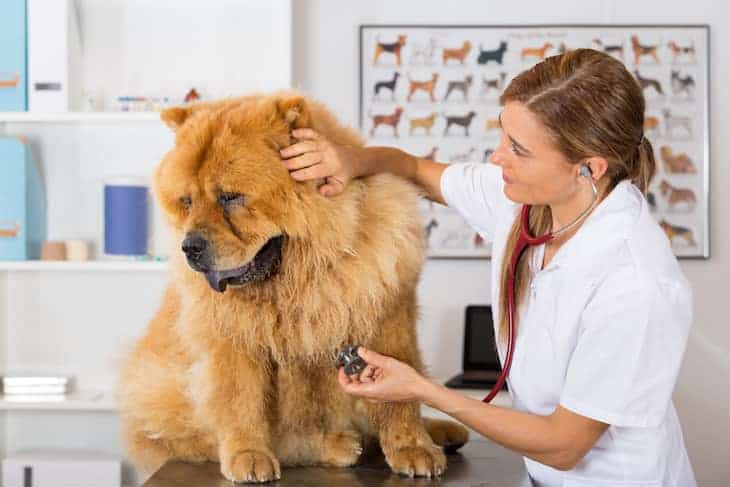
In some cases, vets may prescribe antianxiety or antidepressant medication (the same drugs that are used by people). These medications can help with severe aggression caused by fear or anxiety.
These drugs will have side effects, however, just as they do in people. Since your dog can’t tell you about any adverse effects he may feel, you should consider medicating your dog as a last resort to stopping dog-on-dog aggression.
Where to Find Help
Speak to Your Vet
The first step in dealing with your dog’s aggressive behavior is to talk to your vet. He or she will probably do an exam to rule out medical issues. They may then refer you to a behaviorist.
If your dog shows severe aggression toward other dogs, DON’T try to deal with it yourself!
Dogs will often show displacement aggression toward humans who try to get involved in an altercation. In those situations, your dog is likely to turn on you and may even bite.
A far better option is to call in the pros.
Find a Certified Professional
The two types of consultants who deal with treating dog-on-dog aggression are certified dog trainers and certified dog behavioralists.
A trainer would be adequate for most cases of mild aggression and will be able to offer dog-on-dog aggression training tips.
But for more severe cases, you would probably want to call a behaviorist. They are better qualified to deal with severe behavioral issues and to recommend dog-on-dog aggression solutions.
For more information on how to find a trainer or behavioralist, see How to Handle Dog Aggression Towards Other Dogs.
A Final Word – Making the Decision to Treat Dog-on-dog Aggression Yourself
Dog on dog aggression can be a challenging problem to deal with. When deciding if you want to begin a behavior modification program on your own or to hire a professional, be honest with yourself.
Will you be able to commit to the time and effort it will take? Are you able to be firm and consistent in enforcing the new rules?
Once you decide to start any behavior modification program with your dog, you must be consistent! Your dog must be able to trust your actions and reactions.
Correcting a behavior today and allowing it tomorrow will only confuse him and compromise his training.
To be an effective leader, you need to be sure your dog can rely on your judgment with every command you give. If he can’t, it will undermine the trust and respect you need for his cooperation.
Most importantly, can you realistically ensure the safety of everyone involved?
Have you researched dog-on-dog aggression laws and liability in your area so you know the stakes involved?
Treating dog-on-dog aggression is a serious undertaking, so consider carefully.
If you think you may not be up to the job of correcting your dog-on-dog aggression problem on your own, it’s best to call in a professional.
RESOURCES AND FURTHER READING
- Hebert, Beverly. Whole Dog Journal. Aggressive Dog Training and Socialization. Updated September 2019.
- Martin, Kenneth, DVM, and Lynn Buzhardt, DVM. VCA Hospital. Aggression in dogs.
- Predmore, Mandy, Holland Quick, and Jennifer Ree. UC Davis Veterinary Medicine. The truth about aggression and dominance in dogs.
- Santo, Kathy. American Kennel Club (AKC). How to deal with leash aggression. Aug 9, 2016.
- Sherman, Cynthia Kagarise, Ilana R.Reisner, Lecreca A.Taliaferro, Katherine A.Houpt. Applied Animal Behavior Science. Characteristics, treatment, and outcome of 99 cases of aggression between dogs. March 1999. (Abstract)
- Yin, Sophia. CattleDog Publishing. Handling dominant aggression in dogs.

Paula is an experienced writer who loves dogs and had many of them through the years. Her family always had large dogs—Border Collies, Labs, and Golden Retrievers. When her beloved Golden died of cancer, she decided to practice what she preached and do some research before choosing her next breed. She now shares this knowledge with thousands of dogtemperament.com readers worldwide.